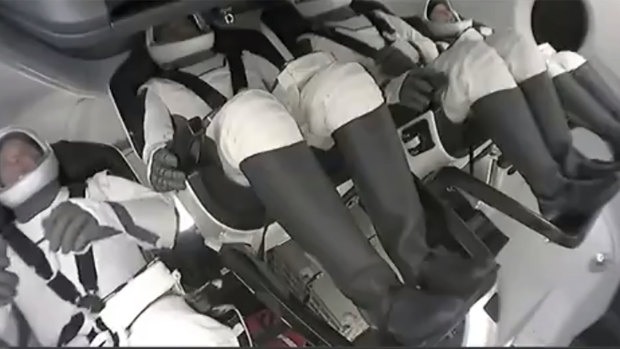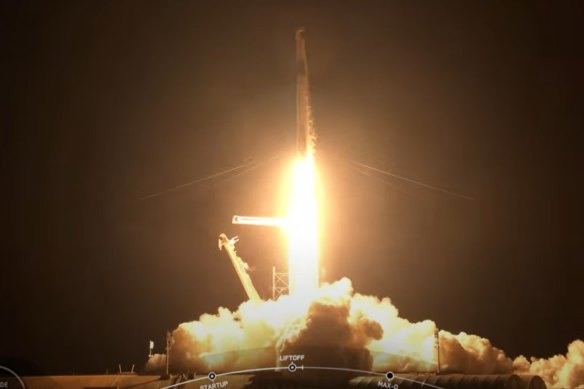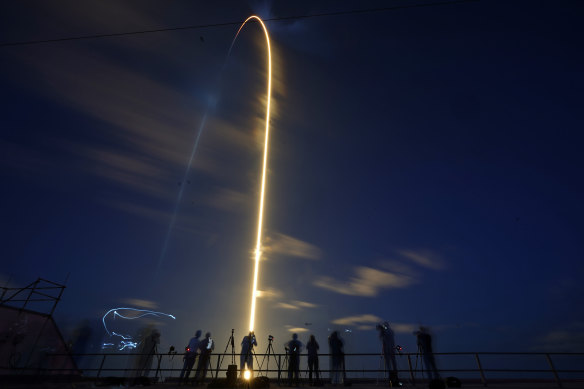- Updated
- World
- North America
- Space
This was published 3 years ago
‘Punch it!’ In a first, SpaceX launches four non-astronauts into orbit
By Marcia Dunn
Cape Canaveral: SpaceX blasted a billionaire into orbit on Wednesday night (Thursday AEST) along with two contest winners and a healthcare worker who survived childhood cancer.
It was the first chartered passenger flight for Elon Musk’s SpaceX and a big step in space tourism by a private company, the first time in 60 years of human spaceflight that no professional astronaut was aboard an orbit-bound rocket.
“Punch it, SpaceX!” Jared Isaacman, who is picking up the tab, urged moments before lift-off.
The Dragon capsule’s two men and two women are looking to spend three days going round and round the planet from an unusually high altitude of 575 kilometres — 160km higher than the International Space Station — before splashing down off the Florida coast at the weekend.
It’s SpaceX founder Elon Musk’s first entry in the competition for space tourism dollars.

The crew aboard SpaceX’s first private flight as it blasts off.Credit: AP
Isaacman did not say how much he paid. He noted upon reaching orbit that few people have been to space — fewer than 600 over 60 years. But he added, “Many are about to follow. The door’s opening now and it’s pretty incredible.”
“Yes, today you must have and be willing to part with a large amount of cash to buy yourself a trip to space,” said Explorers Club President Richard Garriott, a NASA astronaut’s son who paid the Russians for a space station trip more than a decade ago. “But this is the only way we can get the price down and expand access, just as it has been with other industries before it.
Isaacman and the others — Hayley Arceneaux, a physician assistant at the St Jude Children’s Research Hospital in Memphis, Tennessee, and sweepstake winners Chris Sembroski, a data engineer, and Sian Proctor, a community college educator — said before the launch that they had few if any last-minute jitters.
In July, Virgin Galactic’s Richard Branson and Blue Origin’s Jeff Bezos launched aboard their own rockets to spur ticket sales. Their flights barely skimmed space, though, and lasted just minutes.
Though the capsule is automated, the four Dragon riders spent six months training for the flight to cope with any emergency. That training included centrifuge and fighter jet flights, launch and reentry practice in SpaceX’s capsule simulator and a gruelling trek up Washington’s Mount Rainier in the snow.
Four hours before lift-off, the four met with Musk before emerging from SpaceX’s huge rocket hangar, waving and blowing kisses to their families and company employees, before they were driven off to get into their sleek white flight suits. Once at the launch pad, they posed for pictures and bumped gloved fists, before taking the elevator up. Proctor danced as she made her way to the hatch.
Unlike NASA missions, the public won’t be able to listen in or watch events unfold in real time. Arceneaux hopes to link up with St. Jude patients, but the conversation won’t be broadcast live.

Making history: SpaceX’s Inspiration4 launches, carrying an all-civilian crew into orbit.
Their fully automated capsule has already been to orbit: it was used for SpaceX’s second astronaut flight for NASA to the space station.
The only significant change to the capsule, according to Reed, is the large domed window at the top in place of the usual space station docking mechanisms.
Isaacman — founder of payment-processing company Shift4 Payments and an accomplished pilot — said Musk has assured him “the entire leadership team is solely focused on this mission and is very confident.” He added: “That obviously inspires a lot of confidence in us as well.”
Isaacman persuaded SpaceX to take the fully automated Dragon capsule higher than it’s ever been. Initially reluctant because of the increased radiation exposure and other risks, SpaceX agreed after a safety review.
“Now I just wish we pushed them to go higher,” Isaacman told reporters on the eve of the flight. “If we’re going to go to the moon again and we’re going to go to Mars and beyond, then we’ve got to get a little outside of our comfort zone and take the next step in that direction.”

A SpaceX Falcon 9 rocket, with four private citizens onboard, lifts off in this time-exposure photo from Kennedy Space Centre’s launch pad 39-A on Thursday (AEST).Credit: AP
Musk flew in for the launch, as did hundreds of SpaceX workers and representatives of the St Jude hospital. Isaacman is using the flight to try to raise $US200 million ($273 million) for St Jude, half of that coming from his pockets.
While NASA has no role in the flight, dubbed Inspiration4, its managers and astronauts are cheering it.
“To me, the more people involved in it, whether private or government, the better,” said NASA astronaut Shane Kimbrough, who is nearing the end of his six-month space station stay.
AP